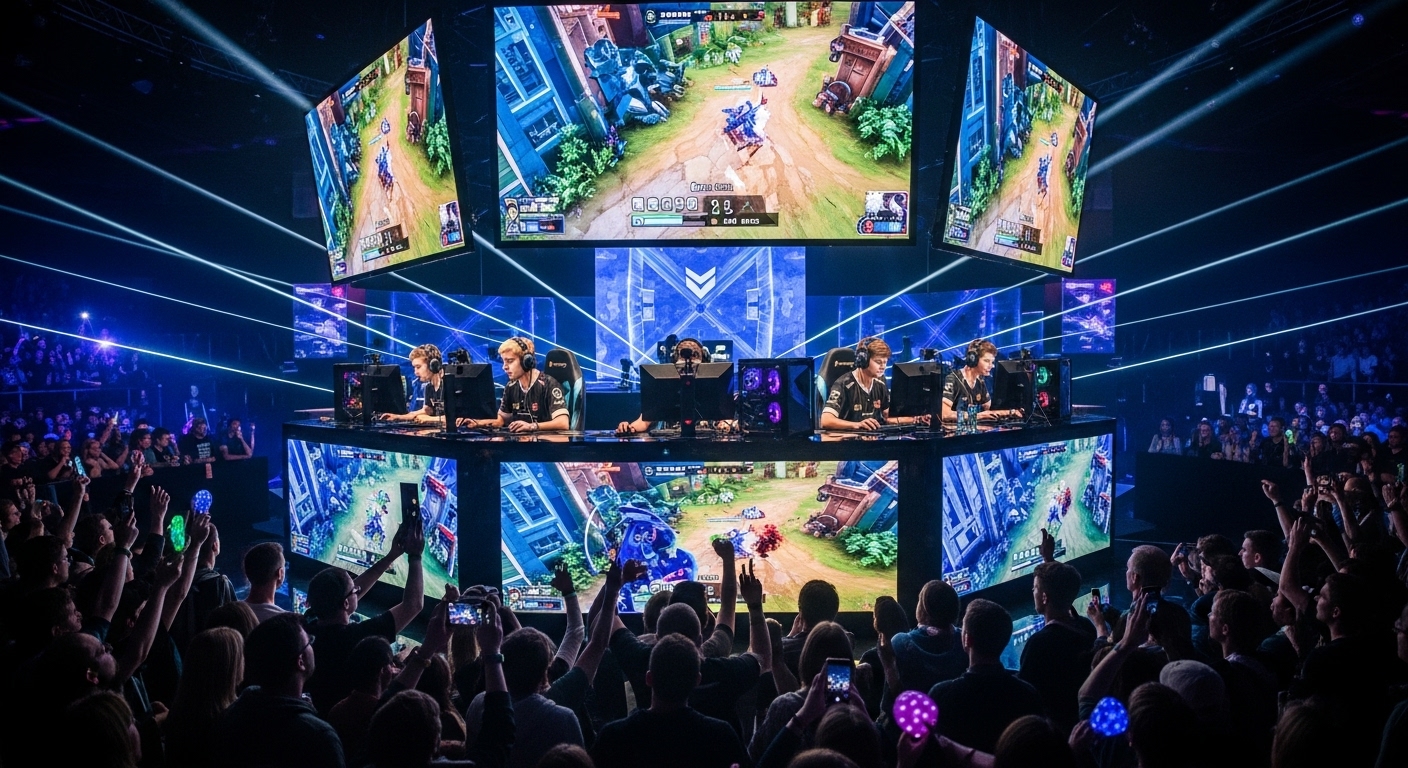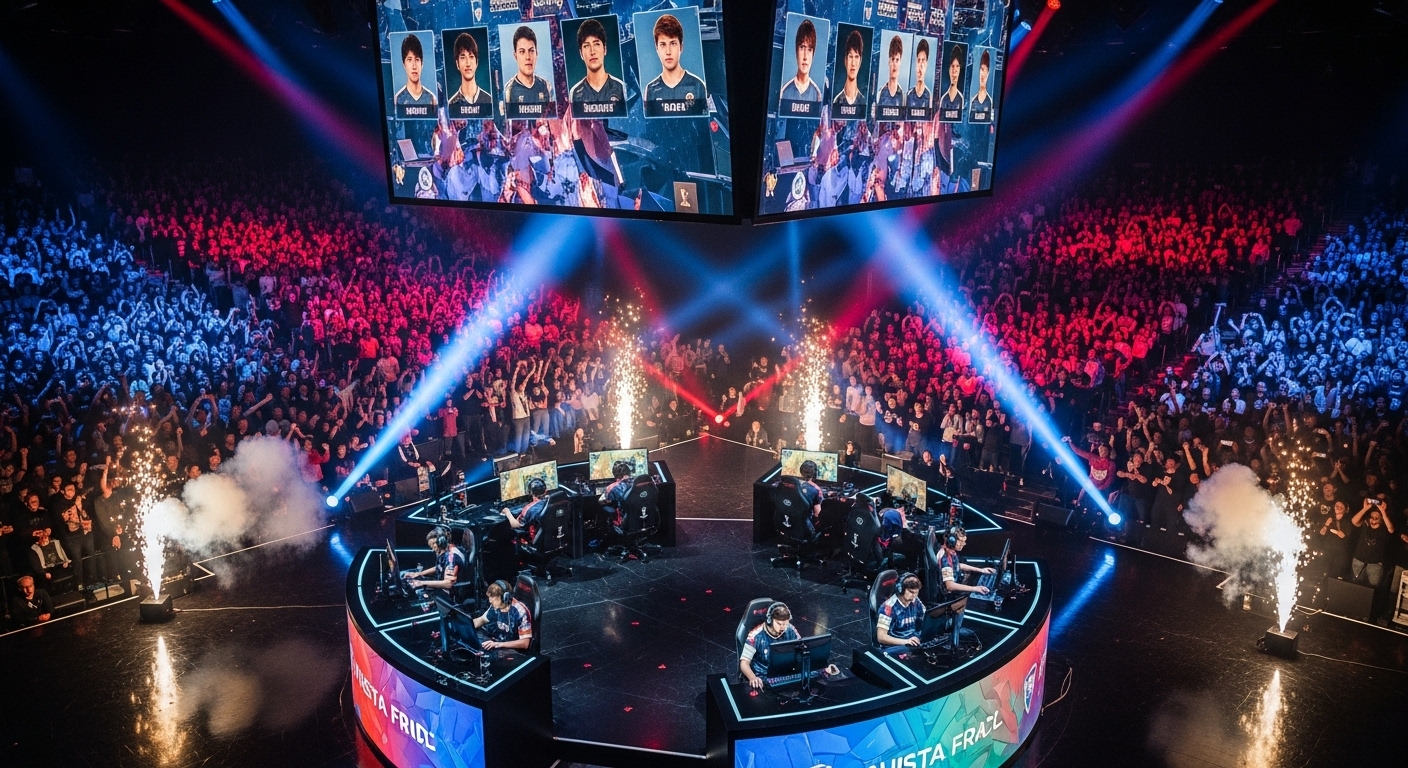The Rise of Esports: From Casual Gaming to Global Spectacle
Esports, short for electronic sports, has evolved from a simple pastime into a massive global industry. What once started as casual competitions among friends has now become a multi-billion-dollar phenomenon that attracts millions of viewers and professional players worldwide. This transformation reflects broader changes in technology, culture, and entertainment, positioning esports as one of the most significant cultural forces of the twenty-first century. The rapid rise of esports has reshaped the way people perceive video games, turning them into serious competitions with professional players, dedicated audiences, and sophisticated infrastructures.
At its core, esports is about competition. Players from all around the world test their skills in high-stakes games, often broadcast to audiences of millions. The competitive scene encompasses a wide variety of game genres, from Multiplayer Online Battle Arenas to First-Person Shooters, Real-Time Strategy games, and Battle Royale titles. Each genre demands unique skills, strategies, and teamwork, creating rich and diverse competitive landscapes. Beyond the games themselves, esports is fueled by community, fan engagement, technology, and global connectivity, making it a multifaceted ecosystem that continues to grow and evolve.
The Origins of Esports: From Arcades to LAN Parties
The roots of esports can be traced back to the early days of video gaming. In the 1970s and 1980s, arcade games like Space Invaders, Pac-Man, and Donkey Kong became the first platforms for competitive gaming. Players would gather in arcades to compete for high scores, earning bragging rights and establishing early rivalries. These informal competitions laid the groundwork for organized esports, introducing the concept of skill-based digital competition.
As personal computers and consoles became more widespread in the 1990s, multiplayer gaming gained momentum. Games like Doom, Quake, and StarCraft allowed players to compete over local area networks and the early internet. The emergence of tournaments with cash prizes and organized rankings marked the beginning of professional esports. Communities of players formed around specific games, sharing strategies, discussing tactics, and building rivalries that would fuel competitive gaming for years to come.
Professionalization of Esports
By the early 2000s, esports began to professionalize. Players formed teams, signed contracts, and received salaries, establishing gaming as a legitimate career path. South Korea became a pioneer in professional esports, particularly with the game StarCraft, where players achieved celebrity status and were celebrated in media and public life. Professional leagues emerged, with structured competitions, sponsorship deals, and organized broadcasting. These developments elevated esports from hobbyist play to a serious, career-oriented pursuit.
Professional esports requires dedication, discipline, and skill. Players practice for hours daily, honing reflexes, strategy, and teamwork. Coaches and analysts help refine tactics and develop game plans, mirroring the structure of traditional sports teams. Players must maintain mental resilience, adaptability, and focus, demonstrating that esports demands both physical and cognitive skills. The professionalization of esports has legitimized it as a serious form of competition and entertainment.
Popular Esports Genres and Titles
Esports encompasses a variety of game genres, each with distinct competitive dynamics and audiences. Multiplayer Online Battle Arenas, or MOBAs, like League of Legends and Dota 2, emphasize team coordination, strategic map control, and character mastery. First-Person Shooters, such as Counter-Strike: Global Offensive and Call of Duty, require precision, reflexes, and tactical awareness. Real-Time Strategy games like StarCraft II challenge players with resource management, decision-making, and adaptability under pressure. Battle Royale games, including Fortnite and Apex Legends, combine survival tactics, quick thinking, and high-stakes competition.
Each genre attracts its own fan base and fosters unique competitive cultures. MOBAs emphasize deep strategy and teamwork, drawing viewers who enjoy analyzing complex plays and high-level coordination. FPS games highlight individual skill and fast reflexes, appealing to audiences seeking intense, action-packed gameplay. Battle Royale titles offer unpredictability and dynamic storytelling, keeping fans engaged with every match. This diversity ensures that esports can cater to a wide range of players and spectators.
The Spectacle of Esports Tournaments
Tournaments are the lifeblood of competitive esports. They bring together top players and teams to compete for prestige, prize money, and recognition. Major events like The International for Dota 2, the League of Legends World Championship, and the Fortnite World Cup draw millions of viewers and multi-million-dollar prize pools. These tournaments create narratives of rivalry, underdogs, and champions, providing fans with dramatic and thrilling experiences.
Esports tournaments showcase not only skill but also strategy, teamwork, and mental endurance. Players must make split-second decisions, anticipate opponents’ moves, and execute complex strategies under immense pressure. The tournament format creates tension and excitement, while live broadcasts and online streams allow fans to witness every moment in real time. These events are spectacle-driven, combining the thrill of competition with entertainment and media production at the highest level.
Streaming Platforms and the Digital Revolution
The rise of streaming platforms has revolutionized esports, enabling global audiences to watch matches in real time. Platforms such as Twitch and YouTube Gaming allow fans to engage directly with players and communities, creating an interactive and participatory experience. Streaming has also empowered players to build personal brands, monetize content, and reach millions of viewers without relying solely on tournament exposure.
Streaming has democratized esports by allowing amateur players to showcase their skills, connect with fans, and gain recognition. Audiences can interact through live chat, polls, and social media, fostering a sense of community. The digital revolution has blurred the lines between spectator and participant, making esports more inclusive and engaging than ever before.
The Cultural Impact of Esports
Esports has become a cultural phenomenon, influencing fashion, music, social interaction, and lifestyle. Professional players are celebrated as celebrities, with fan followings rivaling those of traditional athletes. Merchandise, team branding, and sponsorships contribute to a culture that extends beyond gaming. Esports has challenged perceptions of sports, proving that competition, skill, and teamwork are not limited to physical activity.
Global esports communities encourage international interaction and collaboration. Players from different countries compete together, and fans follow teams across continents. Esports fosters cross-cultural exchange, creating shared experiences that transcend language and geography. It has become a unifying force, connecting people through shared passion, strategy, and excitement.
Careers Beyond Playing
While professional players are the most visible figures in esports, the industry offers a wide range of careers. Coaches, analysts, commentators, event organizers, marketers, content creators, and software developers all contribute to the ecosystem. Tournament organizers manage logistics, production teams handle broadcasts, and analysts study game data to improve performance. Marketing professionals and sponsors drive engagement and revenue, while journalists and social media managers keep fans informed and connected.
The esports industry also intersects with technology, business, and education. Universities offer esports programs and scholarships, recognizing the skill, strategy, and teamwork required to succeed. Esports provides opportunities for entrepreneurship, innovation, and professional growth across multiple disciplines.
Technology and Innovation in Esports
Technology is at the heart of esports. High-performance computers, low-latency internet connections, advanced peripherals, and streaming technology are essential for competitive play. Artificial intelligence and data analytics allow teams to study opponents, refine strategies, and improve performance. Virtual reality, augmented reality, and cloud gaming are creating new immersive experiences, redefining how players and fans interact with esports.
Technological innovation drives both gameplay and spectator engagement. Live statistics, in-game overlays, and interactive broadcasts enhance the viewer experience. AI coaching and analytical tools provide players with insights into performance and strategy, raising the level of competition. The synergy between technology and esports ensures that the industry continues to grow, innovate, and captivate audiences.
Globalization of Esports
Esports is a global industry with hubs in Asia, North America, and Europe. South Korea is known for its professional StarCraft and League of Legends players, while China dominates games like Dota 2 and Honor of Kings. North America and Europe produce top-tier FPS and MOBA players, and emerging regions in Latin America, Southeast Asia, and the Middle East are establishing competitive scenes.
Globalization fosters cultural exchange, diverse strategies, and international rivalries. Players and teams from different backgrounds compete and collaborate, creating a worldwide community. Fans support teams across borders, building a sense of connection and shared passion that transcends geography. Esports has become a truly global phenomenon, uniting people through competition and entertainment.
The Future of Esports
The future of esports is promising and dynamic. Emerging technologies such as virtual reality, augmented reality, and cloud gaming will enhance immersion and accessibility. AI-driven analytics and training tools will continue to elevate competitive performance. Tournaments will grow larger, more immersive, and more spectacular, attracting bigger audiences and sponsorships.
Esports will continue to integrate with mainstream entertainment, education, and business. Universities will expand programs and scholarships, while media companies invest in coverage and content creation. The industry will influence lifestyle, fashion, and global culture, continuing to redefine what competition and entertainment mean in the modern era.
Conclusion: Esports as a Defining Force
Esports has evolved from casual gaming into a global, multi-billion-dollar industry that combines competition, culture, and technology. It has transformed the way people view video games, proving that digital competition requires skill, strategy, and teamwork. The professionalization of esports, the rise of streaming platforms, and the growth of international tournaments have cemented its status as a legitimate career and cultural phenomenon.
Esports is more than a game—it is a global stage where talent, strategy, and creativity meet. It connects people across cultures, inspires innovation, and provides a platform for players and fans to engage in a shared, exciting experience. As technology advances and audiences grow, esports will continue to redefine entertainment, sports, and culture, proving that the digital arena is a force to be reckoned with.




